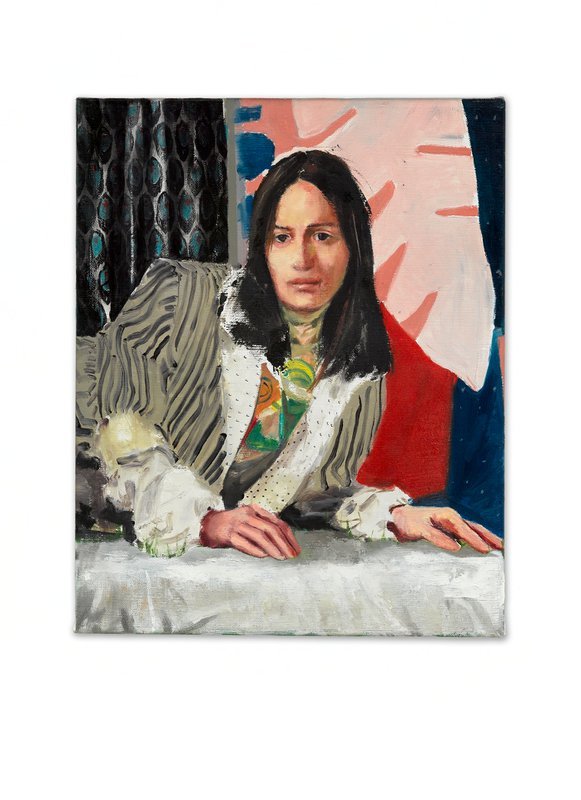Installation view, Patricia Domínguez solo exhibition “Indra’s Net,” curated by Sandhini Poddar, Cecilia Brunson Projects Frieze London booth 2022, Courtesy Cecilia Brunson Projects.
Photograph by Eva Herzog
text by Jennifer Piejko
The early crowd snaked through Regent’s Park in central London, pouring into the tents of the 19th annual Frieze Art Fair from the moment the doors opened. After a string of quiet art-fair seasons, the morning circus of 160 temporary galleries, pop-up cafes (city favorites Petersham Nurseries, Jikoni, and Bao among them) and champagne counters was seemingly full from day to evening.
Perhaps the nearly three years of online viewing rooms, PDF sales lists, and isolation have left us with a longing for the deeply personal as well as the three-dimensional, as the engaging paintings on view leaned into the visceral, from Romanian painter Marius Bercea’s wistful portraits of friends and figures, mostly women, from his native Cluj at Los Angeles and New York gallery François Ghebaly. Hints of the seams of social construction—such as the aftereffects of the country’s 1989 revolution and the resulting creep of consumer capitalism into Romanian society, modern femininity and womanhood, and alienation—are disclosed in the details of his paintings, whose stylings recall paintings by Impressionist artist Mary Cassat and Milan Kundera films.
Marius Bercea
Untitled, 2022
Oil on canvas
40 x 50 cm
Courtesy François Ghebaly Gallery © Marius Bercea
Warsaw and Cologne gallery Wschód present a series of canvases by Polish artist Joanna Woś that depicts scenes from Renaissance painter Filippo Lippi’s fresco The Feast of Herod (1466), part of Stories of St. Stephen and St. John the Baptist inside the Prato Cathedral in Tuscany. The diaphanous figures in shades from sand to terra cotta share side glances and intimacies while seeing right past and through each other. At the other end of the scale, Gagosian presents a towering row of seven paintings by British artist Jadé Fadojutimi, timed with her solo exhibition “Can we see the colour green because we have a name for it?” at the Hepworth Wakefield in West Yorkshire. Neon lines and forms of abstracted foliage race across the canvas in pure, frantic saturation.
Installation View, Joanna Woś, Galeria Wschód Frieze London booth 2022
Reaching out to visitors, works highlighting texture and dimensionality filled the fair, begging to be touched or crinkled in the hand: Shin Sung Hy at Gallery Hyundai (Seoul), Suki Seokyeong Kang at Tina Kim Gallery (New York), Joanna Piotrowska at Phillida Reid (London), Barbara Bloom and Karla Black at Gisela Capitain (Cologne), Acaye Kerunen at Pace, Rossella Biscotti at mor charpentier (Paris and Bogotá). It’s a scandalous feeling now that we’ve gotten accustomed to mediating nearly every work through a digital screen.
Installation View, Acaye Kerunen at Pace Gallery Frieze London booth 2022 © Pace Gallery, London 2022
Photograph by Damian Griffiths, courtesy Pace Gallery
Among the fair’s usual sections Focus and Editions, this year’s special section is “Indra’s Net,” curated by Sandhini Poddar from the Guggenheim Museum in Abu Dhabi. Titled after the ancient Buddhist and Hindu concept of dependent origination, illustrated by intertwined cords that hold a multifaceted jewel at each knot, where each jewel reflects every other jewel, connecting the entire universe. Works included here reflect connections and exchanges in language, history, ancestry, consciousness, and futurity. At New York gallery Jack Shainman’s booth, Richard Mosse’s work Flooded Municipality, Amazonas captures the environmental damage inflicted on the Brazilian Amazon in the craggy reds and blacks that eat away at a flooded residential neighborhood, chronicling ecocide by drone in his signature conceptual photographic technique. At London gallery Cecilia Brunson Projects, Chilean artist Patricia Domínguez’s works stem from her interest in fantastical ethnobotany. Trained in botanical illustration, she used her recent artistic residency at CERN (the European Organization for Nuclear Research) in Switzerland and time with a Peruvian plant healer to inform the hybrid foliage-and-black box paintings (with gemstones), sculptures, and video here. Seen together, it might offer a roadmap into our next dimension. See you in the line to get in there, too.




